On December 7, 1941, as the great battleships Arizona, Oklahoma, and Utah lie paralyzed and burning in the aftermath of the Japanese ttack on Pearl Harbor, a crack team of U.S. Navy salvage divers headed by Edward C. Raymer are hurriedly flown to Oahu from the mainland. The divers have been given a Herculean task: rescue the sailors and Marines trapped below, and resurrect the pride of the Pacific fleet.
Now for the first time, the chief diver of the Pearl Harbor salvage operations, Cmdr. Edward C. Raymer, USN (Ret.), tells the whole story of the desperate attempts to save crewmembers caught inside their sinking ships. Descent into Darkness is the only book available that describes the raising and salvage operations of sunken battleships following the December 7th attack.
Once Raymer and his crew of divers entered the interiors of the sunken shipwrecks—attempting untested and potentially deadly diving techniques—they experienced a world of total blackness, unable to see even the faceplates of their helmets. By memorizing the ships' blueprints and using their sense of touch, the divers groped their way hundreds of feet inside the sunken vessels to make repairs and salvage vital war material. The divers learned how to cope with such unseen dangers as falling objects, sharks, the eerie presence of floating human bodies, and the constant threat of Japanese attacks from above.
Though many of these divers were killed or seriously injured during the wartime salvage operations, on the whole they had great success performing what seemed to be impossible jobs. Among their credits, Raymer's crew raised the sunken battleships West Virginia, Nevada, and California. After Pearl Harbor they moved on to other crucial salvage work off Guadalcanal and the sites of other great sea battles.
-
Creators
-
Publisher
-
Release date
March 15, 2012 -
Formats
-
Kindle Book
-
OverDrive Read
- ISBN: 9781612511023
-
EPUB ebook
- ISBN: 9781612511023
- File size: 1959 KB
-
-
Languages
- English
-
Levels
- Lexile® Measure: 1060
- Text Difficulty: 6-9
-
Reviews
-
Publisher's Weekly
June 3, 1996
Within hours of the Japanese attack on Pearl Harbor, Raymer, an enlisted man, was on a plane headed from San Diego to Oahu. His primary mission: to act as chief diver in the operations to rescue men trapped in sunken battleships. Removing bodies, recovering material and raising the ships themselves could, and would, come later. In this compelling memoir, Raymer describes the multiple hazards of working inside wreckage-strewn warships under the handicaps imposed by available diving technology. Courage was at least as important as competence as the number of dives mounted and the law of averages shifted against the men who went down. Raymer details many harrowing incidents, including one in which he, an arachnophobe, began to panic when a spider stowed away in his diving suit began to crawl over his face in the middle of a dive. The narrative includes lighter passages as well, especially the depictions of how the divers spent their off-duty hours pursuing food, liquor and women. For all its drama and charm, however, Raymer's memoir is useful above all as a case study of the hands-on, un-bureaucratized approach to problem-solving that the U.S. brought to WWII from the beginning. Photographs and maps not seen by PW.
-
Formats
- Kindle Book
- OverDrive Read
- EPUB ebook
subjects
Languages
- English
Levels
- Lexile® Measure:1060
- Text Difficulty:6-9
Loading
Why is availability limited?
×Availability can change throughout the month based on the library's budget. You can still place a hold on the title, and your hold will be automatically filled as soon as the title is available again.
The Kindle Book format for this title is not supported on:
×Read-along ebook
×The OverDrive Read format of this ebook has professional narration that plays while you read in your browser. Learn more here.

